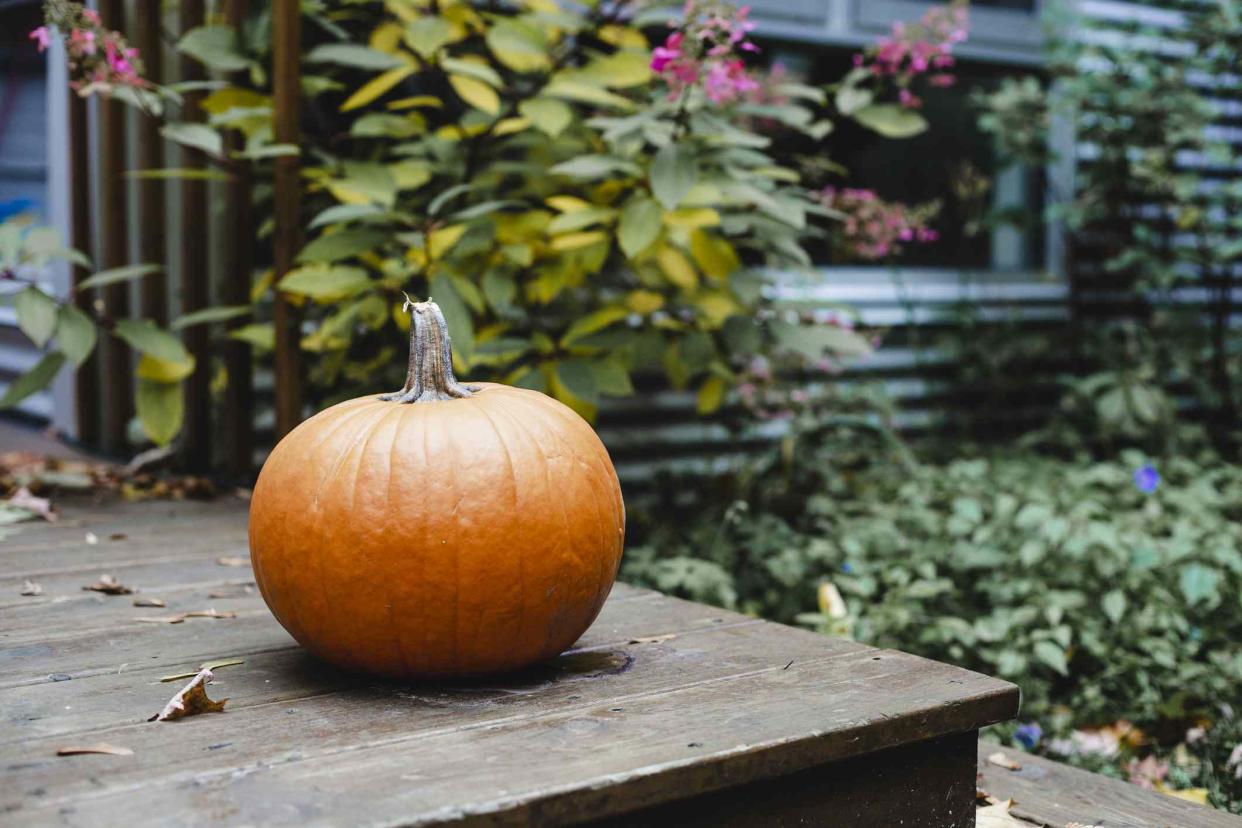How to Stop a Pumpkin Rotting—and What to Do With It If It Has

Linda Raymond/ Getty Images
Fall means hoodies, falling leaves, and all things pumpkin. But the worst kind of pumpkin you can encounter is a rotting or rotten pumpkin, whether its carved or not.
Find out how to extend the life of your pumpkin, spot how to recognize if your pumpkin is rotten, or what to do if you are too late and have a rotten pumpkin on your hands.
How to Stop a Pumpkin From Rotting
Unless you invest in plastic pumpkins, eventually your pumpkins are going to rot. There are a few ways to keep that from happening, but you may need to do some extra work or make a few sacrifices to keep it from happening.
The biggest thing you can do to stop a pumpkin from rotting is to not carve it, which often isn't ideal. If you really want a carved pumpkin to last, follow these helpful tips.
Clean it. Cleaning the inside of the pumpkin will have the biggest impact (aside from not carving it) on how long your pumpkin will last before rotting. Be sure to clean out all the guts, seeds, and pulpy strings with a spoon and scrape until you are down to the flesh. Then, with a mixture of diluted bleach and water, rinse the inside of the pumpkin thoroughly and dry completely.
Keep it cool. When you are not scaring neighbors with your ghoulish gourd, put it in a cool place like an unheated basement or garage, or better yet, if you have the space, place it in your refrigerator.
Blow out the candle. We all know the flickering flame looks cool, but it is hot, and that warm environment accelerates the rotting process by creating a hospitable environment for fungi and bacteria. It also dries the pumpkin from the inside, which shrivels it. Consider using a battery-operated LED flicker tea light instead.
Keep it moist. Every day, give it a spritz inside and out with solution of 10 parts water and 1 part bleach. It will keep your pumpkin moist and kill anything that might cause it to rot.
Treat the inside. Lubricate the edges that have been cut with petroleum jelly. This will seal off the edges, creating a moisture barrier.
Keep the top on. This helps your pumpkin stay fresh for longer (if you also treat the cut edges of the carving). Only do this if you're using an LED light on the inside; never put the top on if you're using a live flame.
WD-40. WD-40 has a million uses, and this is one more. Spraying the outside of your carved pumpkin with WD-40 will keep your pumpkin from rotting for a long time. It seals in moisture, acts as a barrier from pathogens that cause rot, and helps resist freezing. If you decide to go this route, wait at least 24 hours after spraying before placing a candle inside.
How to Tell If a Pumpkin Rotted
The easiest way to know if a pumpkin is rotten is that it is soft, but that is usually the last warning sign. Before that happens, you may notice leaking at the bottom of the pumpkin. Some mold or mildew might start to develop in this area, which is easily missed since it's underneath.
Tip
A healthy pumpkin will last longer than a pumpkin grown in the wrong conditions. A pumpkin grown in the right conditions will be a relatively heavy one for its size, which is an indication of how thick the rind and flesh are. Your thumbnail also shouldn't be able to puncture the rind, and the color should be bright orange.
5 Things to Do With a Rotted Pumpkin
Instead of throwing out a rotted pumpkin, consider composting it, saving the seeds, or giving it to the birds, among other things. Here are five things you that you can do with a rotten pumpkin.
Save the seeds. Though the pumpkin's flesh might be a bit old, the seeds might be salvageable. Unless the seeds are discolored and rotten, they should be fine. Scoop out the insides and put the seeds in a strainer to wash the stringy pumpkin goo off them. Spread the seeds on a baking sheet to dry and either use them for planting or eating.
Feed some hungry animals. It might sound strange that someone might want a rotting pumpkin, but farmers, nature centers, 4H programs, or zoos will often take pumpkins as donations to give as treats for their animals during the fall months. Give your local institutions a call.
Give them to the birds. Nothing will make your local wildlife happier than leaving out your pumpkin. If you have the room, place the pumpkin in the freezer overnight, then cut it in half and fill it with birdseed. You will make your native birds happy and give your area wildlife something to fatten up on before the winter. Freezing it will make it last longer while the animals are feasting.
Watch it grow. Why buy pumpkins to carve when you can grow your own? Find a little patch of land in your yard and clear it to make a pumpkin patch. Once you have a space of about 4-by-4 feet square cleared, dig a hole deep enough for your pumpkin and bury it.
Give to a community garden. Your local community garden or gardening club may be interested in your rotting pumpkin. They might want to compost it or get the seeds.
Read Next: How to Grow Pumpkins From Seed
Read the original article on The Spruce.

